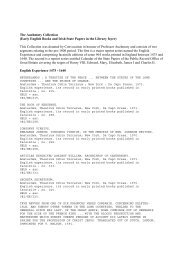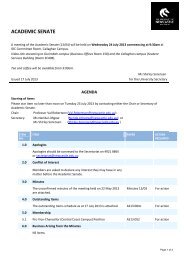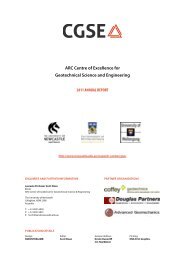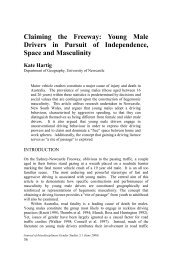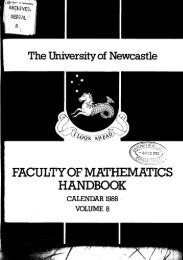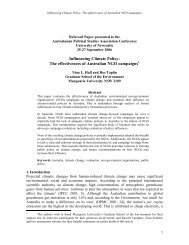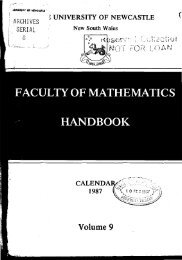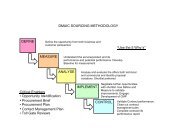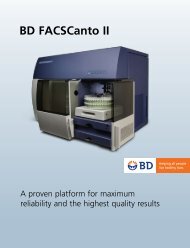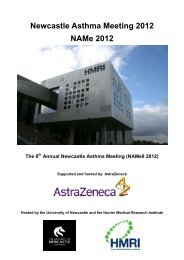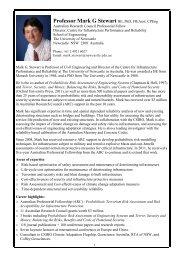n - University of Newcastle
n - University of Newcastle
n - University of Newcastle
Create successful ePaper yourself
Turn your PDF publications into a flip-book with our unique Google optimized e-Paper software.
degree <strong>of</strong> error, ~vhicll aEects also many other lists <strong>of</strong> Australia11<br />
words. Australian vocabularies are made <strong>of</strong>ten by Englishmen,<br />
who, in writing the words, follow the sounds <strong>of</strong> the vowels as used<br />
in English, and sometimes even their own vices <strong>of</strong> pronunciation ;<br />
for instance, kinner is written dowi~ for kinna, and i-ya for<br />
ai-ya. Again, a blackfellow, when asked to give the equivalents<br />
for English words, sometimes fails to understand, and so puts one<br />
mord for another ; thus, in some lists that I have seen, the mord<br />
for ' I ' is set down as meaning ' t110u '; and even in printing mistakes<br />
occur ; for, in Mi-. Taplin's list <strong>of</strong> South Australian dialects<br />
' we ' is gun, and ' you ' is gun also ; the former should probably<br />
be g Bn ; and k ambiy anna is made to mean both ' your father '<br />
and 'his father.'<br />
The Zrst PI-onotr?t.-&Taking all due allov-ance for such defects,<br />
I procebd to examine the Australian pronouns, an1 I hcl that,<br />
notwithstanding the multitude <strong>of</strong> theii- dialect-forms, they have<br />
only a very few bases. These are, for the first pronoun-Ga-ad,<br />
€5-t a, g a-acl-d u, b a, mi, m o ; ancl, for the seconcl pronoun-<br />
Gin, gin-cla, gin-du, bi, bu, gula. I leave the demonstrative<br />
or tyird pronoun out <strong>of</strong> account, as it is not <strong>of</strong> so much importance<br />
to our inquiry. Now, the existence <strong>of</strong> the base ga-ad is proved<br />
by the forms (given above), &-an, gi-na ; the base &a-taorecurs<br />
in gatha, ga-ya, ni-te; ga-ad-du, in g5d-thu, na-thn, a-thu,<br />
ga-tu-ko, kc. ; ba gives wa-an, a-an, and, in South Australia, gapa,<br />
ga-ap, :-pa ; mo and mi are merely s<strong>of</strong>tened forms <strong>of</strong> ba, and<br />
are touncl in mo-to, mo-kok, mi-na, mi-nak, ga-mi. Even so<br />
unpromising a form as 6n-6a (Qneensland) connects itself with the<br />
base g a-ta through g 6-6a (South Australia) ; for some Melanesian<br />
dialects prefer to begin worcls with a vowel, and so transpose<br />
the letters cf an initial dissyllable; thus, fin-6a is for fig-&a=<br />
kii-6a=gCta.* Most <strong>of</strong> the dialect for~ns <strong>of</strong> this pronQun given<br />
above arise from the interchange <strong>of</strong> ng, n, and y ; the Wiradhari<br />
clialect; for example, has gaddu, naddu, yadclu, 'I,' and these<br />
become more liquid still in y allu, -1adn.f Let us obserre here,<br />
also, that the Tasmanian forms ma-na, mi-na, ' I,' come from the<br />
base ma, mi. I have above given six bases for the first prononn in<br />
Australian, and yet there are only two-acl or ta ancl ba; for mi<br />
and mo are only ba differently vocalised, and, in the other three,<br />
ga- is a prefix, as miil be shown further on, while the -du <strong>of</strong> gaad-du<br />
is an emphatic suax.<br />
* The Aneityumese (Ebudan) language is so fond <strong>of</strong> an initial vowel that<br />
it constantly clislocates a consonant in favour <strong>of</strong> a vowel. Our Australian<br />
Vocabularies in this volume have rery few words beginning with vowels.<br />
-t See Appendix, page 60. Dr. Caldwell mas led illto error by the form<br />
ga dlu, whlch an authority told him meant ' we ' in South -4ustralia. Used<br />
alone, it is only ' I,' for gadrlu.<br />
IBTBODUCTION. sliii<br />
Here comes in a most important question. Are these bases ta<br />
and ba exclusively Australian ? Emphatically I say, No ; for I<br />
know that, in Samoan, t a is the pronoun ' I,' and tZ (for t ii-ua)<br />
is ' we two,' 'ita is ' me,' anel ta-tou is ' we'; la'u (i.e., ta-ku, !<br />
for d) is 'my.' I quote the Samoan as the reyreseiltative <strong>of</strong> the<br />
Polynesian dialects. And yet the Maori pronouns <strong>of</strong> the first<br />
and second pronouns present some interesting features. They<br />
are :-<br />
' I,' ' me '-Aha~, au, awau.<br />
' We two '-Tana, maua.<br />
'We '-Tatou, matou, matau.<br />
' 319 '-Taku, toku, aku, oku, abaku.<br />
' Thou '-Koe ; clz~nl, korua, 2~lzc., koutou.<br />
' Pour '-Tau, tou, nu, on, takorua, takoutou.<br />
Here in 'we two,' 'we,' and 'my,' I see both <strong>of</strong> our Australian baseforms<br />
ta and ma; in 'my' I find the Australian possessive genitive<br />
s&x ku, gu%; and in :we7 I take the -tou to bo for tolu the<br />
Polynesian for 'three,' three being used in an indefinite way to mean<br />
any number beyond two.? Then, in Fiji, I fincl that ' I,' ' nle ' is<br />
au, which may be for ta-u, for the binal form <strong>of</strong> it is -cia-ru (i.e.,<br />
da+rua, 'two'), the ternal is -cla-tou (i.e., cla+tolu, 'three'),<br />
and the plural is cla. In the Motu dialect <strong>of</strong> New Guinea, ' I' is<br />
lau, <strong>of</strong> which the plural is (ijzclusice) ai (for ta-i 1) and (exclusice)<br />
i-ta. In other parts <strong>of</strong> New Guinea, ' 1 ' is cl a, ya-u, n5-u, na-na,<br />
la-u, and, for the plural, ki-ta, i-ta (qfi Sanloan). Ebudanparallels<br />
are-'I,' e-nau, iau, ain-ya-k; for the plural, hi-da, ki-to, a-kity ;<br />
possessive forms are tio-ku, otea, u-j a. The Tukiok forms iau,<br />
io, yo ; da-ra, cla-tul, dat, corresponcl mainly with the Fijian,<br />
and are all from the root cla, ta.<br />
I think that I have thus proved that our Australian base ta is<br />
not local, but sporadic, ancl that, so far as this eviclence has any<br />
weight, the brown Polynesians have something in common wit11<br />
the Melanesian race.<br />
hly next inquiry is this-Has this base, ta, da, ad, any connection<br />
with the other race-languages! And at once I ren~enlber<br />
that the old Persian for ' I ' is acl-am, and this correspoilcls with<br />
the Sanskrit ah-am, <strong>of</strong> ~vhicl~ the stem is agh-, as seen in the<br />
Grseco-Latin ego ancl the Germanic ich. I assume an earlier<br />
form <strong>of</strong> this base to llave been ak-, but, whether this Inclian ak-<br />
or the Iranian ad- is the olcler, I cannot say. At all events, the<br />
change <strong>of</strong> ak into at ancl then into ad, ancl conversely, is a com-<br />
mon phonetic change, and is at this nlonlent going 011 copiously in<br />
Polynesia. The ak is now in present use in the Malay aku, 'I.'<br />
*The possessive termination for persons in Awabakal 1s -n m ba ; thls I<br />
take to be for gu-mba, the gu being the possessi\re formative in Wiradhari ;<br />
it corresponds to the Ebuclan ki, which is used in the same way.<br />
4-C' Singular, Dual, and (all else) Plural.



